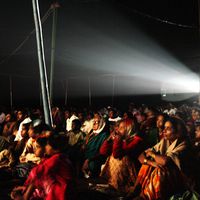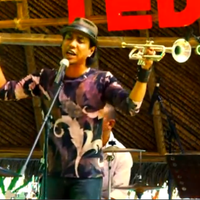..At A Tent Theatre Near You..’ : The Itinerant Tent Talkies Of Western Maharashtra, India.
As the lunar calendar heralds the full moon after the crop gathering season, pilgrims in remote hamlets in Maharashtra (western India) begin preparing to participate in the annual religious fairs that are hosted by nodal villages. Simultaneously, another set of devotees start getting ready for their annual pilgrimage. The owners of the touring talkies companies begin piling on their reels, projectors, posters and tickets to accompany the fairs, a tradition established for about six decades now. The season of the tent talkies is the only time in the year when the patrons in hundreds of villages stand enraptured by the big screen, which fuels dormant dreams and spins a world of fantasy for its patrons. Ensnared by the silverscreen, thousands travel from the neighboring villages to the fairs, where, vying for their attention are acrobats, trick shows, traditional folk theatres, daredevil stuntmen and the tent talkies, which, unlike the other traditional entertainments, is a rare annual experience.
In Mumbai- that has been the main site of the production of film entertainment in India, the signifiers of a vast film industry, production of its cinema, its exhibition and reception are ubiquitous sights. Moreover, these various elements are scattered across the extensive geography of the city. Whereas, in these villages located a few hundred miles from Mumbai- an analogous world of cinema comes into existence once every year, created by the arrival of the tent cinemas on a small tract of land barricaded by barbed wires.
This enclosure, with about five to fifteen such tent companies, each with their respective trucks, tantalising announcements through hundreds of antiquated speakers, alluring hand-painted banners adorned with typically symbolic cultural decorations like fresh sugarcane stalks invite countless men, women and children who throng the religious fairs. This transforms the remote village into a mystical space that would surely appear bizarre on any other day in this quiet hamlet. For such remote villages, the tent talkies are the only exposure to reel magic as these patrons of cinema still remain unexposed to standing, permanent theatres. The fare of the tent cinemas is an eclectic mix of films hawked from village to village. The tent cinemas were traditionally considered a small parallel window of exhibition for regional Marathi cinema, but given the demands from the audience, they have now expanded to include other crowdpulling films- like old Hindi action films, dubbed Hollywood flicks and even dubbed regional language action films from south India which do brisk business in the tent cinemas. But the owners continue to take into consideration the main target audiences- the women, whose patronage ensures that films run to packed tents courtesy a strong word-of- mouth publicity. Hence, social dramas, mythological and even comedies make for a favoured line up. Most of the tent cinemas offer a range of films through the day, spoiling the patrons for choice- and the accompanying food and shopping stalls make it truly a rural multiplex experience.
One can notice the participatory, almost interventionist approach of all those involved with this unique system of projection and reception of cinema. This system of local exhibition lives by its own rules- foreign yet much-Indianised film projectors, loud posters specially hand painted for audiences in the villages, home-grown marketing styles and an ingenous mobile architecture which can be heaped up inside a truck. Moreover, in the universe of cinema created by tent cinema owners in the villages, shows run back to back all day, except between six am to noon, dialogues and songs are re-run on demand, and films can be changed midway if the majority audience finds it boring.
Despite the longstanding tradition of the run of these cinemas, the sustainability of the nomadic set ups is threatened by the new all-pervasive, neo-modern idioms of entertainment. The talkie owners have been forced to retain ticket prices as charged years back (an average of rupees ten per show, equivalent to one fourths of a dollar) - in a frantic attempt to appeal to the dwindling numbers easily lured by accessible VCDs and omnipresent cable channels. The owners are striving hard to preserve this tradition which needs to keep reinventing itself for its patrons - given the stiff competition by the more enticing modes of novel entertainment. In their bid for an instantaneous connect with their audiences some local film producers even draw themes from real life incidents- honour killings, farmers’ suicides, political scandals etc, along with mainstream Bollywood films which are employed as teasers to pull crowds.
Long before the journey of these cinemas became a tradition, it was initiated when the amalgamation of the neo cultural experience of cinema was brought about by the establishment of talkies companies by maverick lawyers, merchants and producers who had first witnessed cinema in the cities. Seeing a potential audience in the thousands who traditionally assembled in the socio-religious gatherings, they had set up touring cinema companies and set about raiding the fairs armed with a cache of mythological films, appealing to the rustic milieu. Notably, herein lies an unknown story of a cultural association between Asia and Europe. The tent cinema set ups were developed around European projectors- mostly Bauer (also Iskra, Prevost, Micron and even Pathe in few instances) which were bought second hand and traveled atop buffalo carts during the first few years. Descendants of some of the first owners bought Bauer projectors from a Parsi businessman who was selling five of them on a footpath near Roxy Theatre in Bombay. The first light from the projector brought the magic of cinema in the lives of the villages who watched agape. For some of the mythological films, they would often not even look at the screen, but kept staring in the direction of the projection beam- in the belief that God will arrive from the projector.
The European projectors, an import from the city are much Indianised now- yet, their presence has extended beyond being just a technical facilitator for exhibition of cinema. Found in somewhat incongruous settings, they have helped build a self-sustaining set up of the traveling cinemas, which is a crucial part of the lives of so many patrons all across villages in the state of Maharashtra. The existence of the projectors gave rise to a small community of self styled mechanics and engineers who thrived on repair and modification of the machinery they kept suitably ‘conditioning’ to Indian weather. They were gradually assimilated into the families of the tent talkies owners and are still retained, even after some have sold off their set ups.
What began in early 1940s as a tentative experience of exhibition of cinema, through an amalgamation into an age-old tradition of the fairs, has now metamorphosed into a cultural tradition itself, for those people who gather to worship their on-screen heroes after they bow their heads at the altar of the divine. Yet, the number of the touring cinema companies which rose to about three hundred during the golden era of the tents, has now dwindled to just about fifty.
To revive the diminishing fortunes for this venture, the exhibition and distribution committee of the Akhil Bhartiya Marathi Chitrapat Mahamandal (the governing body for Marathi cinema) has also sounded multinationals for a tie-up. "One cannot treat these talkies as operating in isolation, they are a part of the local entertainment media setup. Since media cannot thrive merely on subscription, we have already invested in specific brand development. Even the foot falls in the fairs can be used creatively, for marketing and involvement of corporate sponsors." says Ajay Sarpotdar, who heads the Touring Talkies wing. Some touring cinema companies have managed to involve a few household brands like Wheel detergent as sponsors, for greater sustenance. They also wish to urge the government to extend seasonal permission- so as to be able to pitch their tent talkies in villages that have no permanent theatre at all- during the months even when there are no religious fairs.
Despite the touring cinemas facing a near-inevitable extinction, standing up against the onslaught of slick, all pervasive modes of entertainment - one can clearly note how the tents are unwilling to fold up without a strong fight for survival.
Shirley Abraham
Shirley’s work is currently being supported by a Fellowship from India Foundation for the Arts, under the Arts Research and Documentation program for 2008-09.
--
picture credit: Amit Madheshiya
Similar content
28 Oct 2009
posted on
12 Jun 2011
posted on
21 Nov 2012
deadline
15 Jul 2011
By Kerrine Goh
07 Oct 2006




